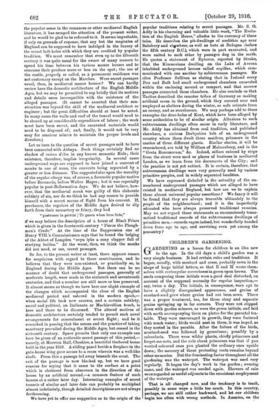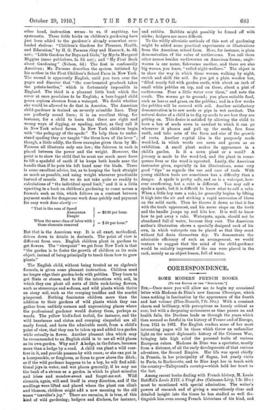CHILDREN'S GARDENING.
GARDENING as a lesson for children is an idea new to the age. In the old days a child's garden was a very simple business. It had certain rules and traditions. It began, usually, with mustard and cress, probably sown in the shape of large initial letters, so that E and M wrote them- selves with rectangular correctness in green upon brown. The seeds composing these initials were a good deal disturbed, on account of the supposed necessity for regular inspection,— say, twice a day. The initials, in consequence, wern apt to have a slightly disorganised appearance, and grains of mustard-seed grew where grains had not been sown. There was a proper treatment, too, for these stray and separate grains springing up in far corners. They were not clipped down with garden scissors, as were the green initials, and laid with earth accompanying them on plates for the parental tea- table. They were encouraged in growth, they were fostered with much water ; birds would nest in them, it was hoped, as they nested in the parable. After the failure of the birds, mustard-seed was followed by geraniums; possibly by a calceolaria. There were wilder plants, chiefly primroses and forget-me-nots, and the rule about primroses was that if you wanted coloured ones you planted the ordinary ones upside down; the memory of those protesting roots remains beyond other memories. But the dominating factor throughout all the gardening was the waterpot. The waterpot was used very regularly. It began the day's work in the garden ; evening came, and the waterpot was needed again. Showers of rain were rewarded as useful adjuncts to the consistent employment of the waterpot.
That is all changed now, and the tendency is to teach, possibly in some ways a little too much. In this country, perhaps, we are still rather backward, and let our children begin too often with wrong methods. In America, on the
other hand, instruction seems. to us, if - anything, too systematic. Three little bOoks on children's gardening have just been added to the gardener's already somewhat over- loaded shelves : "Children's Gardens for Pleasure, Health, and Education," by H. G. Parsons (Gay and Hancock, 4s. 6d. net); "Little Gardens for Boys and Girls," by Myrta Margaret Higgins (same publishers, 38. 6d. net) ; and "My First Book about Gardening" (Nelson, 6d.) The first is confessedly American; Mr. Parsons describes the system initiated by his mother in the First Children's School Farm in New York. The second is apparently English, until you turn over the pages and discover that "the rose-breasted grosbeak takes the potato-beetles," which is fortunately impossible in England. The third is a pleasant little book which the cover at once proclaims to be English; a bare-legged child pours copious showers from a waterpot. We doubt whether she would be allowed to do that in America. The American child-gardener is trained on severely scientific lines. They are perfectly sound lines ; it is an excellent thing, for instance, for a child to learn that there are right and wrong ways of digging, or spading, rather, as they call it in New York school farms. In New York children begin with "the pedagogy of the spade." To help them to under- stand spading they are taught "the three laws of the lever "; though, a little oddly, the three examples given them by Mr. Parsons all illustrate only one law ; the fulcrum in each is placed between the power and the weight. However, the point is to show the child that he must use much more force to lift a spadeful of earth if he keeps both hands near the handle than if he puts his left hand near the blade. There is some excellent advice, too, as to keeping the back straight as much as possible, and using weight whenever practicable instead of muscle. But we do not take quite so readily to Calculations of " the individual speed limit," and it is a little upsetting in a book on children's gardening to come across a formula such as this, which follows on a contrast between payment made for dangerous work done quickly and payment for easy work done slowly :—
" That is the sum of Speed Annoyance = $2.00 per hour. Danger When the same class of labor with these elements removed = $.20 per hour.'"
But that is the American way. It is all exact, methodical, driven down to details in decimals. The point of view is different from ours. English children plant in gardens to get flowers. The "viewpoint" we get from New York is that "the garden is to foster the growth of children as its main object, instead of being principally to teach them how to grow plants." • The English child, without being treated as an algebraic formula, is given some pleasant instruction. Children need no longer edge their garden-beds with pebbles. They learn to get flints or stones, and to fill the interstices with soil, in which they can plant all sorts of little rock-loving flowers, such as stonecrops and sedums, and wild plants which thrive on stony soil, such as the creeping toadits.x and the scarlet pimpernel. Nothing fascinates children more than the addition to their gardens of wild plants which they can gather from unlikely corners and unpromising places where the professional gardener would destroy them, perhaps as weeds. The yellow bird's-foot trefoil, for instance, and the wild heartsease and cistus and creeping cinquefoil are all easily found, and have the admirable merit, from a child's point of view, that they can be taken up and added to a garden while actually in flower. Another pleasant idea which may be recommended to an English child is to use all wild places as its own garden. Why not P A hedge, in the future, becomes more than a hedge by a road. A child can plant a wild rose- tree in it, and provide passers-by with roses; or she can put in a honeysuckle, or foxgloves, or ferns to grow above the ditch; or if the wild gardener happens to be a boy, he will find addi- tional joys in water, and wet places generally, if he may use the bank of a stream as a garden in which to plant mimulus and irises and meadow-sweet and forget-me-not. Wild clematis, again, will seed itself in every direction, and if the seedlings were lifted and placed where the plant can climb and blossom, children might add a new meaning to the old name "traveller's joy." There are enemies, it is true, of this kind of wild gardening; hedgers and ditchers, for instance,
and rabbits. Rabbits might possibly be fenced off with slicks; hedgers are more difficult.
To the wildly altruistic methods of this sort of gardening might be added some practical experiments or illustrations from the American school farm. Here, for instance, is plain demonstration of the value of earthworms. You call them other names besides earthworms on American farms; angle- worms is one name, fish worms another, and there are also big worms, you learn, "called night-walkers." The object is to show the way in which these worms, walking by night, enrich and shift the soil. So you get a plain wooden box, "filled nearly full with garden earth, with about an inch of small white pebbles on top, and on these, about a pint of earthworms. Pour a little water over them," and note the result. The worms go to ground ; you place suitable food, such as leaves and grass, on the pebbles ; and in a few weeks the pebbles will be covered with soil. Another satisfactory demonstration is to sow seeds or pips in wet sawdust. The natural desire of a child is to dig up seeds to see how they are getting on. This desire is satisfied by allowing the child to have a box of seeds sown in sawdust to which it can go whenever it pleases and pull up the seeds, free from earth, and take note of the form and size of the growth of roots. Another capital idea is the purposely made weed-bed, in which weeds are sown and grown as an exhibition. A small plant makes its appearance in a child's garden. Is it a sown plant or a weed ? A journey is made to the weed-bed, and the plant in conse- quence lives or the weed is uprooted. Lastly, the American instructor gives, especially in his illustrations, some very good " tips " as regards the use and care of tools. With young children tools are sometimes less a difficulty than a danger. A spade is pretty safe, and so is a waterpot, how- ever overflowing, but a rake is different. You may call a spade a spade, but it is difficult to know what to call a rake. When a little boy uses a rake, he generally begins by lifting it high into the air and striking a rapid succession of blows on the solid earth. Then he throws it down so that it lies with the teeth- uppermost, and his nurse steps on the teeth and the handle jumps up and hits her. It is well to know how to put away a rake. Waterpota, again, should not be abandoned full of water, because they rust. The American author's illustration shows a specially designed rack of his own, in which waterpots can be placed so that they must without fail drain themselves dry. To demonstrate the admirable efficiency of such an arrangement, we would venture to suggest that the mind of the child-gardener would be suitably impressed if the can were placed in the rack, merely as an object-lesson, full of water.















































 Previous page
Previous page